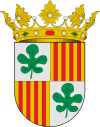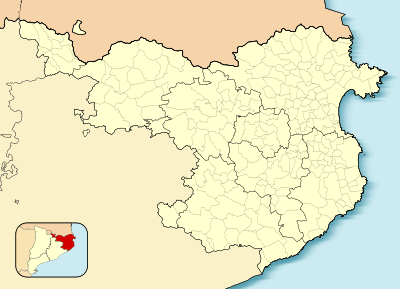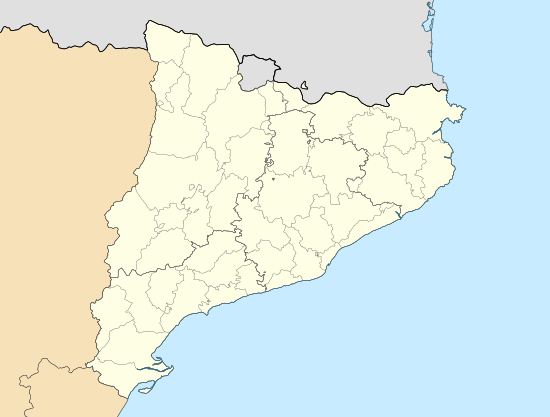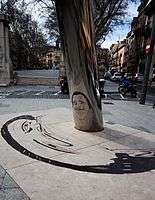Figueres
Figueres (pronounced [fiˈɣeɾəs]; Catalan for '"fig trees"', Spanish: Figueras) is the capital of the comarca of Alt Empordà, in the province of Girona, Catalonia, Spain.
Figueres | |
|---|---|
 The Dalí Museum | |
 Flag  Coat of arms | |
 Figueres Location in Catalonia  Figueres Figueres (Catalonia)  Figueres Figueres (Spain) | |
| Coordinates: 42°16′00″N 2°57′54″E | |
| Country | |
| Community | |
| Province | Girona |
| Comarca | Alt Empordà |
| Government | |
| • Mayor | Jordi Masquef Creus (2018)[1] |
| Area | |
| • Total | 19.3 km2 (7.5 sq mi) |
| Elevation | 39 m (128 ft) |
| Population (2018)[3] | |
| • Total | 46,381 |
| • Density | 2,400/km2 (6,200/sq mi) |
| Demonym(s) | Figuerenques |
| Climate | Csa |
| Website | figueres |
The town is the birthplace of artist Salvador Dalí, and houses the Teatre-Museu Gala Salvador Dalí, a large museum designed by Dalí himself which attracts many visitors. It is also the birthplace of Narcís Monturiol, inventor of the first successful machine-powered submarine. Also born here was Mónica Naranjo, one of the best selling Spanish singers of the 1990s and 2000s.
History
The town's name derives from that of Ficaris, of Visigoth origin. In 1267, King James I of Aragon conceded it fuero rights, but four years later Count Ponç IV of Empúries set the town on fire.
During the Spanish Civil War, it remained loyal to the Republican government, and was repeatedly bombed by the Nazi and Fascist Italian aviation.[4]
It was one of the most heavily bombed Catalan cities during the Civil War, in 1938, and, especially, at the beginning of 1939, when thousands of people passed through the town on their way into exile. The number of bombing victims cannot be known with certainty, but could be close to 400.[5]
Spain's Republican government held its final meeting of the civil war (on 1 February 1939) in the dungeons of its Sant Ferran Castel.[6]
Figueres recovered starting from the 1950s, consolidating its economy around the tourism industry.
Main sights
- Sant Ferran Castle, built in 1753 during the reign of Ferdinand VI of Spain. It has a pentagonal layout, with a total perimeter of 5.6 km (3.5 mi).
- Parish church of St. Peter, in Gothic. It has a single nave with side chapels.
- Teatre-Museu Gala Salvador Dalí (19th century, renovated in the 1960s). It incorporates a tower from the ancient walls.
- Technical Museum of the Empordà, a technology museum with hundreds of antique typewriters
- Museu de l'Empordà
 A surrealist tribute to Salvador Dalí at the base of the Rambla, Figueres
A surrealist tribute to Salvador Dalí at the base of the Rambla, Figueres
Transport
Situated in the northeast corner of Catalonia, Figueres is about 40 km (25 miles) from Girona, 140 km (87 miles) from Barcelona, 60 km (37 miles) from Perpignan, and 50 km (31 miles) from Girona-Costa Brava Airport. It is also served by its own railway station just east of the old town center.
Figueres has been connected since December 2010 to the high-speed rail network with the start of services connecting Figueres to Perpignan via LGV, allowing direct TGV services to Paris in 5 h 27 min. Connections to Madrid-Barcelona via AVE began on 8 January 2013 and the trip takes 53 min (12 min to Girona).[7]
Notable people
- Montserrat Minobis i Puntonet (1942-2019), feminist journalist
- Salvador Dali (1904-1989), world renowned artist
- Maverick Viñales (1995-), MotoGP racer for Team Yamaha
Twin towns




References
- References
- "Ajuntament de Figueres". Generalitat of Catalonia. Retrieved 2015-11-13.
- "El municipi en xifres: Figueres". Statistical Institute of Catalonia. Retrieved 2015-11-23.
- Municipal Register of Spain 2018. National Statistics Institute.
- "Figueres, la Gernika de Catalunya". Publico (in Spanish). 2013-04-03. Retrieved 2020-01-03.
- "ICIP participates in the historical memory project "(silences) Figueres under the bombs". International Catalan Institute for Peace. Generalitat de Catalunya". International Catalan Institute for Peace. Retrieved 2020-01-03.
- "Castell de Sant Ferran | Figueres, Spain Attractions". Lonely Planet. Retrieved 2020-01-03.
- Kallas, Siim (8 January 2013). "The European commission welcomes the entry into service of the high speed line between Barcelona and Figueres – last stage of Spain-Europe high-speed connection". European Commission. Retrieved 10 January 2013.
- "Figueres i Alcalà la Real: l'agermanament" Archived 2011-08-05 at the Wayback Machine, Ajuntament de Figueres
- "Figueres, Spain - St. Petersburg". www.stpete.org. Retrieved 2016-06-16.
- "Figueres i Craiova preparen el seu agermanament", Empordà.info
- Literature
- Panareda Clopés, Josep Maria; Rios Calvet, Jaume; Rabella Vives, Josep Maria (1989). Guia de Catalunya, Barcelona: Caixa de Catalunya. ISBN 84-87135-01-3 (Spanish). ISBN 84-87135-02-1 (Catalan).
External links
| Wikisource has the text of the 1911 Encyclopædia Britannica article Figueres. |
| Wikimedia Commons has media related to Figueres. |
| Wikivoyage has a travel guide for Figueres. |
- Figueres Council: Figueres Council (Catalan)
- Government data pages (in Catalan)